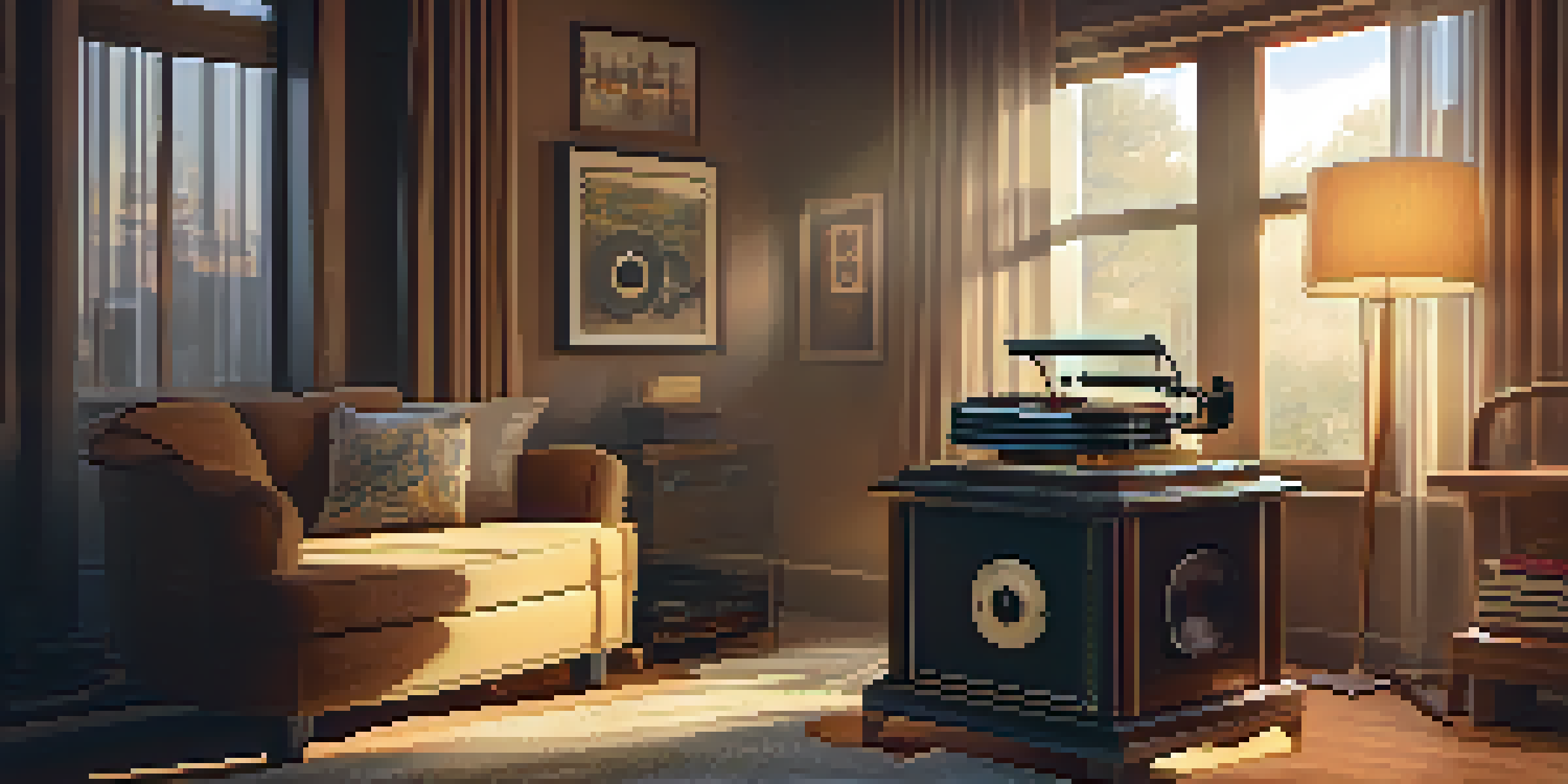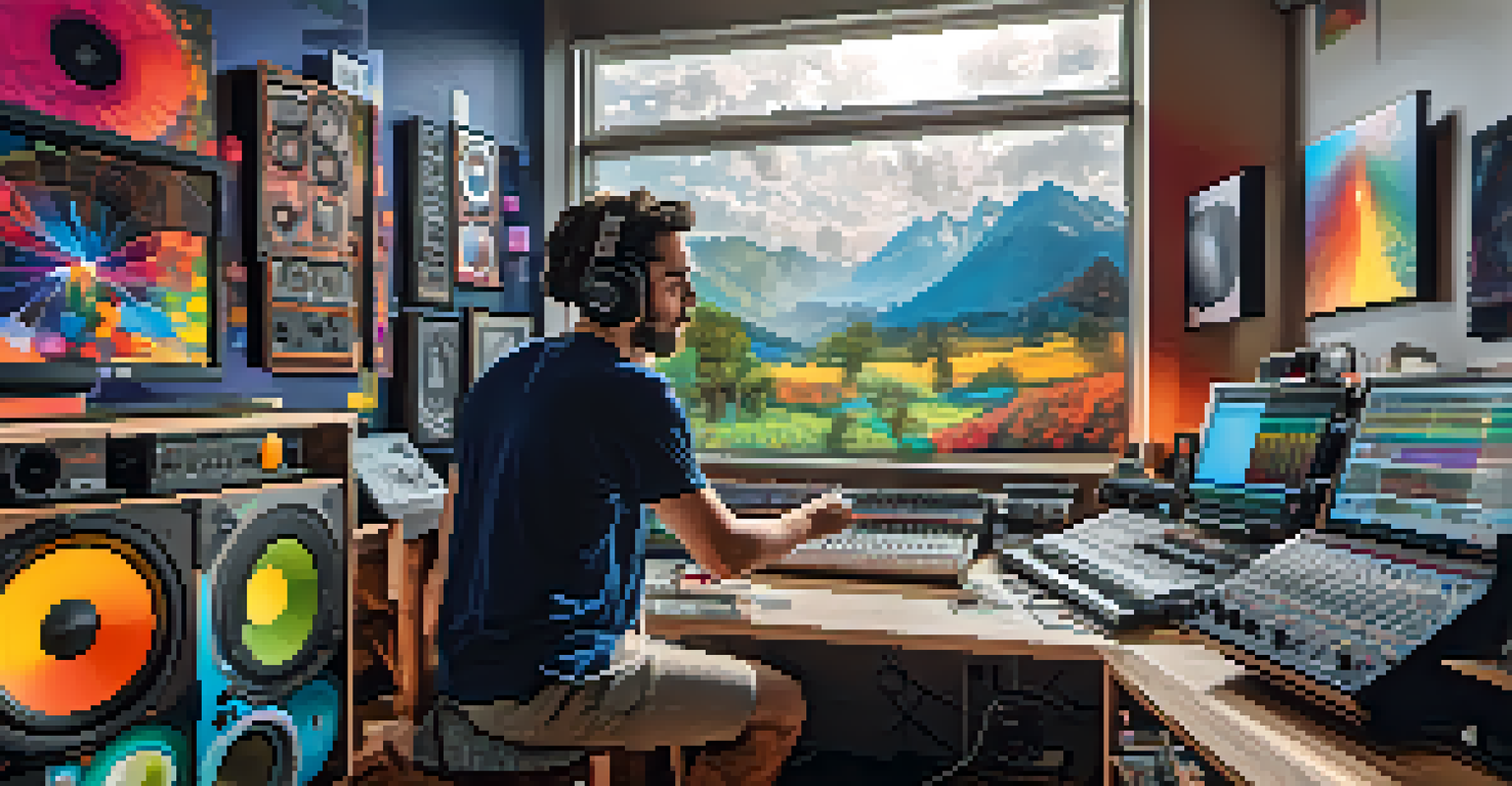The Birth of Sound Recording: A Historical Perspective

The Dawn of Sound: Early Innovations in Recording
The journey of sound recording began in the 19th century, during an era of remarkable innovation. In 1860, Édouard-Léon Scott de Martinville created the phonautograph, a device that could visually capture sound waves. Although it couldn't reproduce sound, it laid the groundwork for future developments in audio technology.
Music can change the world because it can change people.
By the 1870s, Thomas Edison took the concept further with his invention of the phonograph. This groundbreaking device not only recorded sound but could also play it back, creating a sensational experience for audiences. Edison's phonograph marked a pivotal moment in history, allowing people to hear voices and music long after the moment had passed.
These early innovations sparked a curiosity that led inventors down a path of experimentation. Each advancement built upon the last, leading to a world where sound could be captured, preserved, and shared, ultimately changing how we experience music and communication.
The Rise of the Gramophone: A Game Changer
As the 20th century approached, the gramophone emerged as a significant advancement in sound recording. Unlike the phonograph, which used cylinders, the gramophone utilized flat discs, making it easier to mass-produce records. This innovation not only improved sound quality but also made music more accessible to the public.

With the advent of the gramophone, music began to flourish in a way that had never been seen before. Record companies sprang up, artists recorded their songs, and music lovers could enjoy their favorite tunes at home. The social impact was profound, as families gathered around these devices to listen to the latest hits.
This shift in sound recording technology also paved the way for the popularization of genres like jazz and blues. Artists could now reach wider audiences, and the music industry began to shape cultural trends, leading to a vibrant and dynamic landscape of sound that resonated with listeners everywhere.
Magnetic Tape: Revolutionizing Recording Techniques
The invention of magnetic tape in the 1930s brought about a seismic shift in sound recording. This new medium allowed for high-quality sound capture and made editing and re-recording much more efficient. With magnetic tape, sound engineers could manipulate recordings in ways that were previously unimaginable.
The only truth is music.
By the 1950s, magnetic tape had become the standard for both radio and music recording, leading to the rise of multi-track recording techniques. Artists could layer sounds, creating richer and more complex arrangements. This newfound creativity led to iconic albums and innovative sounds that defined the era.
The flexibility of magnetic tape also contributed to the development of home studios, empowering amateur musicians to experiment with recording. As technology became more accessible, a new wave of creativity flourished, further expanding the boundaries of what was possible in sound recording.
The Digital Revolution: A New Era of Sound Recording
The late 20th century heralded the arrival of the digital revolution, transforming sound recording once again. Digital audio workstations (DAWs) emerged, allowing musicians and producers to record, edit, and mix with unprecedented precision. With the ability to manipulate sounds through software, creativity soared.
Digital recording also brought about the rise of formats like MP3, making music easier to share and distribute. This shift had a profound impact on the music industry, changing how artists connected with their fans and how consumers accessed music. The world of sound recording became more democratized, allowing for a plethora of voices to emerge.
However, the digital age also brought challenges, such as piracy and the struggle for artists to monetize their work. Despite these hurdles, the evolution of sound recording continues to thrive, as new technologies emerge, creating fresh opportunities for innovation in music production.
The Impact of Sound Recording on Culture
Sound recording has profoundly shaped global culture, transcending geographical and linguistic barriers. Music can now reach audiences worldwide, influencing social movements and cultural trends. From protest songs to pop anthems, recorded sound has played a vital role in expressing collective sentiments.
Consider the impact of recording icons like Bob Dylan or the Beatles; their music served as a backdrop to significant historical events. Sound recording not only preserved these moments but also gave voice to the experiences and emotions of generations. The ability to capture and share these sounds has forever changed how we understand our past.
Furthermore, the evolution of sound recording has also influenced other art forms, including film and theater. Soundtracks and sound design have become essential elements of storytelling, enriching the viewer's experience. This cross-pollination of art forms highlights the importance of sound recording in shaping contemporary culture.
The Future of Sound Recording: Trends and Innovations
As we look to the future, sound recording technology is poised to evolve even further. Innovations like artificial intelligence and immersive audio are on the horizon, promising to enhance the way we create and experience sound. AI-driven tools can assist artists in generating new ideas, pushing the boundaries of creativity.
Additionally, the rise of virtual reality (VR) and augmented reality (AR) presents exciting opportunities for sound recording. Imagine an album that allows you to step into a fully immersive soundscape, where you can experience music in a whole new way. This merging of technology and art could redefine how we listen to and interact with sound.
Yet, as technology evolves, it’s essential to remember the human element of sound recording. The passion and creativity of artists will always be at the heart of music. As we embrace new tools and trends, maintaining that authentic connection to the art form will be key to the future of sound recording.
Preserving the Art of Sound: Challenges Ahead
While the advancements in sound recording are exciting, they also present challenges, particularly in preservation. As formats change and technology advances, there’s a risk of losing access to older recordings. Ensuring that we preserve the audio heritage of past generations is crucial for future generations to appreciate.
Organizations and enthusiasts are actively working to digitize and archive recordings, but it requires resources and commitment. The challenge lies not only in preserving the technology but also in maintaining the context and cultural significance of these recordings. After all, each piece of recorded sound tells a story worth preserving.

Moreover, as the industry shifts towards streaming services and digital distribution, artists must navigate new dynamics regarding ownership and rights. Understanding these challenges will be essential for preserving not just the recordings themselves, but also the artists behind them and the stories they tell.